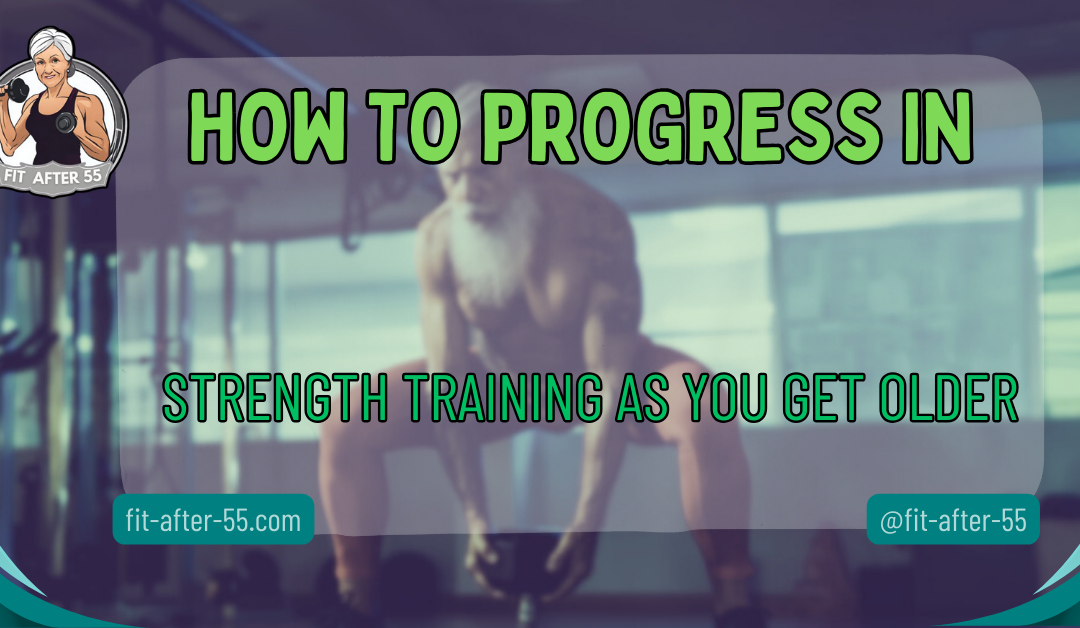How to progress in strength training? You might think it’s all about piling on more weight or cranking out endless reps, but for many of us, especially as we get older, that strategy can lead to frustration and injury. The good news is, building and maintaining strength doesn’t have to be a battle against your body. In fact, with a smarter approach, you can keep getting stronger and feel more energized well into your golden years. This guide will unveil the secrets to effective strength training for mature adults, from understanding how your body changes with age to incorporating exercises that improve mobility and balance. So ditch the intimidation factor, and get ready to discover how strength training can become your key to a healthier, happier you.
How to Progress in Strength Training: Building Strength and Resilience for Your Mature Years
You may believe that strength training is the exclusive domain of the young and vigorous. But that is not the case. I’m here to dispel that myth and affirm that age is not a barrier to improving your muscle strength. In fact, as you get older, strength training becomes even more crucial to your overall well-being.

It’s a common misconception that as we get older, a decline in strength and vitality is inevitable. However, what many don’t realize is that maintaining muscle mass and bone density can significantly impact quality of life and independence in later years.

The aim of this article isn’t just to reassure you that progress in strength training is possible at any age, but to equip you with the KNOW-HOW to achieve it. Through intelligent adjustments and persistence, you’ll discover that your body can still surprise you with its capability for strength and resilience.
So, if you’re ready to look past the number of candles on your birthday cake and focus on the kilos you lift at the gym, let’s set the stage for a transformative approach to strength training tailored for your mature years. In the next section, you’ll learn about the physiological changes that come with aging and how a shift in your mindset can lay the groundwork for continued progress.
Key Takeaways:
- Adjust your mindset: Strength training is beneficial at any age. Focus on quality over quantity and prioritize exercises that improve your daily life.
- Train smarter, not harder: Focus on proper form and technique to avoid injury. Gradually increase weight or reps and prioritize rest for muscle recovery.
- Stay motivated and track your progress: Celebrate small wins and consider working with a trainer to create a program tailored to your needs.

Understanding the Aging Body & Adjusting Your Mindset
Appreciating how the body changes with age is crucial in crafting a strength training program that works for you. As muscles age, they naturally lose some mass and strength – a process known as sarcopenia. Your body may take longer to recover from exercise. But it’s not all bleak; you can combat these changes with regular training.

Reshaping your mindset goes hand in hand with understanding these physiological shifts. It’s about embracing a ‘quality over quantity’ philosophy. Heavy lifts every day aren’t the goal anymore; instead, aim for a steady and sustainable practice that keeps you strong and healthy.
The progress you achieve will depend on your ability to set appropriate goals. This means shifting focus away from the raw numbers, like how much weight you can lift, to longer-term and more holistic achievements – such as preserving mobility, boosting stamina, and enhancing overall well-being.
Next, I’ll guide you into the foundational principles of strength training as you age – the tactical know-how that’ll ensure your time in the gym is effective, safe, and contributes to your longevity.
Essential Training Principles for the Older Adult
As we age, incorporating specific principles into our strength training regimen is crucial for both progress and safety. Let’s get into the core aspects that I advocate for every client who’s looking to stay strong in their later years.

Exercise After Fifty: The Smarter, Not Harder Approach
| Principle | Description |
|---|---|
| Warm-up | Spend at least 10 minutes on dynamic stretching and light aerobic activity to prime muscles and joints, reducing the risk of injury. |
| Form and Technique | Prioritize proper form over heavier weights. Focus on mastering movement patterns to prevent injuries. |
| Progressive Overload | Gradually increase stress on your body during training. For older adults, this means small and steady increments in weight or repetitions. Listen to your body and progress only when adapted to the current routine. |
| Rest and Recovery | Schedule rest days into your training plan. Every workout should be followed by at least one recovery day focused on good sleep, proper nutrition, or light activity for muscle repair. |
Nutrition & Supplementation to Support Muscle Strength
As I grow older, I realize that maintaining muscle isn’t just about the time I spend lifting weights; it’s equally about what I put on my plate. Diet plays a pivotal role in supporting muscle strength and overall health. Consuming adequate protein is critical, as it’s the building block of muscle. I ensure that my meals are balanced, with sufficient protein to aid in muscle repair and growth after workouts.

Maintaining Energy Levels Through Diet
Energy levels can also wane with age, making it essential to focus on a diet rich in vitamins and minerals that can enhance vitality. I’m mindful of including a variety of fruits, vegetables, whole grains, and lean proteins to cover all my nutritional bases. Proper hydration can’t be overlooked either, and I make a conscious effort to drink plenty of water throughout the day.
Supplements: A Cautious Approach
There’s often a temptation to turn to supplements, and while some can be advantageous, I tread this path with caution. Before considering any supplementation, I consult with a healthcare provider. I’m particularly wary of products claiming miraculous results, as they can do more harm than good.
Prioritizing Whole Foods, with Smart Supplementation
A well-considered supplementation strategy might involve adding vitamin D for bone health, especially if I’m not getting enough sunlight, or omega-3 fatty acids to support heart health. However, I always prioritize getting nutrients from whole foods first, viewing supplements as just that—supplementary.
Food choices can have a significant impact on workout effectiveness and recovery time. So I pay close attention to my body’s signals, adjusting my diet to make sure I’m fueling and refueling correctly. This mindful approach to nutrition ensures that my body has what it needs to strengthen and recover, setting the stage for ongoing training and progress.
Staying Motivated and Measuring Progress
I understand the journey you’re on. As your body ages, commitment to strength training can challenge your motivation. But remember, the benefits far outweigh the fleeting discomforts of a tough workout. I will share methods to help you stay on course and recognize the strides you’ve made in your strength training voyage.

Tracking Your Progress: Building Confidence
First, it’s essential to monitor your progress meticulously. Whether it’s a traditional workout log, a digital app, or even short video clips of your sessions, these records serve as a testament to your dedication and display your improvements over time. They enable you to see the increases in weights lifted, the growth in repetitions, or the enhancement of your overall form and endurance.
Spice Up Your Workouts: Avoiding Plateaus
Variety is not just the spice of life; it’s also a catalyst for continuous improvement in training. When routines become monotonous, it’s time to switch things up. Introducing new exercises can inject excitement and can help overcome plateaus. Equally, varying intensity or switching between free weights and machines can provide fresh challenges for your muscles.
Building Strength Through Community
Lastly, there’s strength in numbers. A strong community or a workout buddy can fuel your commitment. If you prefer professional guidance, a personal trainer who understands the nuances of training in older age can be invaluable. Their expertise can adjust your workout plan to ensure it’s aligned with your goals, safe, and effective.
As you move forward, keep in mind that any progress, no matter how small it may seem, is a triumph. Every additional pound lifted, each extra repetition, and the newfound energy you experience in daily life are clear indicators of your growing strength. Embrace those achievements. They are the markers of your hard work and the best motivation to keep pushing forward.
Understanding the Concern
I understand this concern completely. Strength training might seem daunting if you’re worried about falls or have limitations in your movement. A good friend of mine, Margaret, felt the same way. For years, she avoided exercise because she worried about losing her balance. But then she took a tumble at home and it really shook her confidence.
A Success Story: Margaret’s Journey
That’s when she decided to take a chance on a chair-based exercise class. To her surprise, she discovered she could still get a great workout without putting undue stress on her joints. It wasn’t just about lifting weights; there were exercises that improved her core strength and stability, which in turn helped her feel more confident on her feet.
The best part? After a few months of consistent exercise, Margaret noticed a significant improvement in her balance. She started walking without fear again, even tackling the slightly uneven sidewalk near her house with newfound confidence.
Strength Training for Improved Mobility and Balance
Here’s the key takeaway: strength training can actually improve your mobility and balance, even if you have limitations to start with. There are a variety of exercises that can be adapted to your specific needs, whether you prefer to work out seated in a chair, use bodyweight exercises, or hold onto a wall for support.
Remember: Progress is Progress
Remember, progress is progress, no matter how small. Even small improvements in your strength and balance can make a big difference in your daily life and overall well-being. Don’t hesitate to talk to your doctor about what kind of exercise program would be right for you. They can help you connect with a physical therapist or certified trainer who specializes in working with older adults.
How to Progress in Strength Training: Key Takeaways for a Stronger You
Remember, strength training isn’t just about aesthetics; it’s an investment in your long-term health and independence. We’ve explored how to adjust your mindset to prioritize quality over heavy lifting, focusing on goals that enhance your daily life. We discussed the importance of incorporating proper warm-up, focusing on form, and respecting your body’s need for recovery.

This journey isn’t about reaching a specific destination; it’s about continuous progress. Celebrate every milestone, from mastering a new exercise to noticing a newfound spring in your step. Remember, there’s no shame in seeking guidance – a certified trainer or physical therapist can tailor a program to your unique needs and goals.
So, are you ready to embark on a strength training adventure that will empower you not just physically, but also mentally and emotionally? Take that first step today. You deserve to feel strong, capable, and confident at any age. Now get out there and conquer your next workout!
How can I progress safely and effectively?
While piling on weight or reps might seem tempting, it can lead to injury. Focus on “quality over quantity” with proper form and technique. Here are key principles for safe progression:
- Warm-up: Dedicate 10 minutes to prime your muscles and joints.
- Focus on form: Lighter weight with perfect form is better than risking injury.
- Progressive overload: Gradually increase weight or reps as your body adapts.
- Prioritize rest: Schedule rest days for muscle repair.
What should I eat to fuel my workouts?
Diet plays a vital role. Here are some tips for proper fueling:
- Protein: Consume adequate protein to aid in muscle repair and growth.
- Nutrients: Include fruits, vegetables, whole grains, and lean proteins.
- Hydration: Drink plenty of water throughout the day.
How can I stay motivated and see results?
Stay motivated and measure your progress with these tips:
- Track progress: Use a log, app, or video clips to witness improvements.
- Embrace variety: Introduce new exercises to prevent plateaus.
- Find support: A workout buddy or trainer can boost your commitment.
- Celebrate small wins: Every rep, weight increase, or newfound energy is a victory!
Level Up Your Fitness After 55!
Unleash your inner athlete. Find expert tips, inspiring stories, and a supportive community all in one place.
- Fuel your fitness journey: Explore engaging workouts, product reviews, and more on our website: [fit-after-55.com]
- Join the movement: Connect with a vibrant community passionate about staying active at any age on our Facebook group: here
Let’s redefine what it means to age actively. It’s time to feel stronger, healthier, and happier – together!

